Uber Eats was among the experimental products launched in 2014 by Travis Kalanick, the then-CEO, to expand the company’s ride-sharing system into other transportation industries.
Uber Eats was first tested in a small region of Santa Monica in California, delivering a set price menu. More neighbourhood eateries were encouraged to join as the service rapidly grew to neighbouring communities, including West Hollywood.
Uber Eats debuted in New York, Chicago, and Barcelona within a year formerly dominated the food delivery market worldwide but has been forced to reduce its operations in recent years. In 2019, it stopped serving South Korea and India, and in 2020, it stopped serving several nations in Eastern Europe.
As part of its exit from Russia, it also reached an arrangement with Yandex, a Russian search engine.
This post will look at some of Uber Eats’ most impressive statistics. But first, let’s know what Uber Eats means and how it works.

What is Uber Eats?
Uber Eats is a business that offers food delivery services.
Expanding on its initial ride-hailing service, Uber now also provides an on-demand food service that works as a go-between for you and your favourite eateries, delivering takeout from both independent and national chains to your front door.
You may use the Uber Eats website, the Uber Eats app on iOS, or the Uber Eats app on Android to make an order. You may order using the app in different ways, all functionally equivalent. Pick a dining establishment, select, and then pay for your meal.
Despite keeping a cut of between 20% and 30% of purchases, Uber Eats still hasn’t made a profit. Uber claims that Eats will be lucrative once it reaches critical mass and the market settles down. However, shareholders are wary because even during the epidemic, when Uber’s gross bookings tripled, it still failed to produce a profit.
However, Uber Eats has recorded declining losses annually, suggesting that, as the business matures, it may eventually become profitable.
Uber Eats and similar businesses are trying to cut expenses by having eateries set up “dark kitchens” in less expensive areas that simply focus on delivery. Despite Uber’s recent announcement that it will no longer provide the space for these kitchens, several fast-food franchises have taken advantage of the opportunity to move in.
Since Uber’s ride-hailing platform generated 50% less income in 2020 than in 2019, Eats became crucial to the company’s survival. Although Uber anticipates ride-hailing to replace food delivery once many significant nations return to normalcy, Eats has produced more income than its Mobility business since Q2 2020.
Uber Eats General Statistics
- Data from Food Delivery Services Users
- One in three Australians who live in big cities use food delivery services.
- Sales from restaurants, cafes, and food delivery services account for 12% of the total.
- Over the past three years, the meal delivery business in Australia has increased by 18%.
- About $12,300 was spent on meals and non-alcoholic beverages in Australia in 2018.
- In 2021, Uber Eats will have 12.8% of Australians as customers, up from 11.5% in 2020. One-fifth of millennials and 20% of Generation Z are responsible for the increase.
- As of early 2019, the platform served over 18 cities and was compatible with more than 30,000 Australian eateries.
- The parent firm, Uber Technologies Corporation, has a value of $120 billion, whilst Uber Eats earned a valuation of $20 billion.
- About 47 million people worldwide downloaded Uber Eats in 2022, making it the number two most popular meal delivery app that year.
- About 100 million programme copies have been downloaded from Google Play.
- Uber Eats has maintained a 27% market share in the US over the last four years, as of 2022.
- As of April 2021, the business had more US users than any other meal delivery business. Its market share was highest (55%) in Miami and lowest (11%) in San Francisco.
- Recent market data shows that Uber Eats is rapidly expanding its part of the meal delivery business and now holds a 23% share, ranking it second behind the market leader.
- A staggering 486 million people use Uber Eats monthly to order food.
- There are reportedly over 130 million regular consumers of Uber Eats in the US.
- In approximately 2022, Uber Eats brought in roughly $55.778 billion in revenue.
- Uber Eats recorded its highest quarterly revenue bookings of $14.315 billion in 2022 Q4.
- The enormous number of 1.7 billion requests made by Uber Eats users in 2021 is a testament to the rising demand for food delivery solutions.
- By 2022, Uber Eats will have partnered with more than 825,000 restaurants.
- Nearly $11 billion was earned by Uber Eats all over the world in 2022.
- The firm now operates in 45 nations and has more than 6,000 locations.
- In 2022, the business employs over 400,000 people in the US only to deliver food.

A Glance at Uber Eats:
Do you want a direct link to this paragraph? Simply copy this — Put it where you’d like to paste it.
As of 2021, Uber Eats has over 66 million consistent users on all continents, making it one of the most significant meal delivery businesses.
The site has attracted a sizable user base in several countries, including the US, Brazil, and India.
A streamlined app lets customers quickly and easily place orders from various eateries. The site also provides a simplified delivery solution that is available in several places throughout the globe.
Revenue for Uber Eats is projected to increase by over 70% in 2020, continuing a trend of steady growth. The growing number of satisfied customers and the platform’s dedication to improving their lives through cutting-edge tools drive this expansion.
Customers love the app because it’s easy to use, keeps track of past purchases, and makes suggestions based on what they like. Uber Eats has positioned itself as a cutting-edge, alluring meal delivery company by adding innovative features like contactless food delivery and instantaneous order monitoring.
Uber Eat’s Market Share of Users by Regions
A combination of circumstances, including population density in major cities and a penchant for on-demand options, has been the US as Uber Eats principal market in the past few years.
Uber Eats now delivers a wider variety of cuisines and offers more delivery areas nationwide. The US market is highly competitive; thus, the corporation invests extensively in marketing campaigns to stay relevant.
Uber Eats company is a significant participant in the US meal delivery sector while facing obstacles and governmental attention in some places.
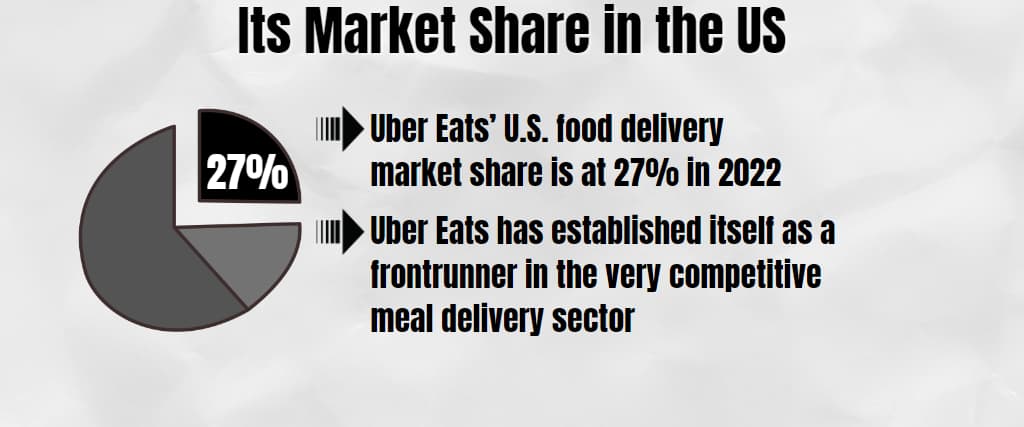
Its Market Share in the US
Uber Eats’ U.S. food delivery market share is at 27% in 2022, essentially unchanged from four years prior.
With this percentage of the market, Uber Eats has established itself as a frontrunner in the very competitive meal delivery sector. The company’s success stems from its efficient and streamlined business approach and ability to deliver accessible and dependable service to clients.
The business has maintained its market share through innovative relationships with local eateries and by offering clients affordable pricing plans.
There needs to be more indication that Uber Eats’ status as a significant player in the meal delivery sector will change soon.
Uber Eats Food Delivery Market Share
Uber Eats is the most well-liked meal delivery solution in the US. Its cutting-edge business approach has attracted a significant user base there.
People too busy to cook for themselves or their families often turn to Uber Eats because of how quickly and reliably it delivers tasty food.
It will be fascinating to observe how Uber Eats responds to the changing dynamics of the food delivery sector by introducing and refining new features.

How Many People Use Uber Eats?
With 486 million active users, Uber Eats is the most popular app for delivering food.
It’s remarkable how many individuals rely on Uber Eats for meal deliveries. Not surprisingly, considering that Uber Eats is among America’s most popular meal delivery applications, most clients are in the US.
It is believed that around one-third of all adults in the US have used the application at least once. This demonstrates Uber Eats’s profound effect on the food delivery sector. Observing the platform’s development and growth over the next few years will be fascinating.
How Many Americans Order Food Delivery Services From Uber Eats Users?
There are reportedly over 130 million regular consumers of Uber Eats in the US.
Its popularity may be attributed to several things, including its easy-to-use interface and various dining selections. It’s opened up fresh job possibilities for meal delivery drivers nationwide and made it easier for individuals to eat their favourite foods without leaving the house.
The future of the food sector is bright because of Uber Eats, which has already had a considerable effect.
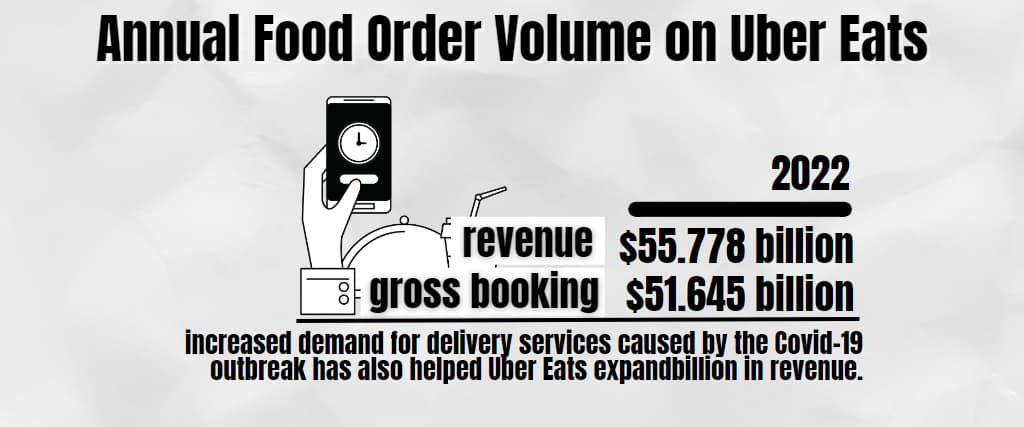
Annual Food Order Volume on Uber Eats
In approximately 2022, the business brought in roughly $55.778 billion in revenue.
The prior year’s gross booking stood at $51.645 billion; thus, this is a considerable rise.
The growth is attributable to Uber Eats’ entry into previously untapped regions and the purchase of many local food delivery services over the past 12 months.
The increased demand for delivery services caused by the Covid-19 outbreak has also helped Uber Eats expand. This strong showing positions Uber Eats as a frontrunner in the food delivery market.
Quarterly Uber Eats Bookings
Uber Eats recorded its highest gross bookings in the fourth quarter of 2022, surpassing $14.315 billion.
The stat was a significant turning point for the business, which is expanding quickly lately. The Uber Eats platform’s growth into new areas and the addition of additional functions that have increased the service’s appeal to users are two reasons for the rise in gross bookings.
The business has also made significant investments in advertising and marketing efforts, which have raised brand identity and attracted additional users to the service. Uber Eats is projected to continue to be among the top companies in the delivery food market going forward and is well-positioned for development and success.
Is Uber Eats AOV Yoy?
AOV data for Uber Eats shows that users place a high value on the service, with an AOV of $26.19.
This accomplishment stands out given the fierce competition and rapid evolution of the meal delivery market to satisfy consumer demand.
According to the numbers, Uber Eats is helpful to its users and has carved out its unique place in the industry. Given the rising demand for food delivery services online, Uber Eats seems well-positioned to continue its rapid expansion.
Orders Uber Eats Users Place Each Year
Uber Eats saw an incredible 1.7 billion orders in 2021, startlingly reflecting delivery businesses’ rising popularity.
Despite setbacks caused by the COVID-19 epidemic, Uber Eats continued to grow and improve, satisfying customers’ appetites in many nations with tasty, freshly prepared meals.
The platform’s popularity stems from several aspects, including its ease of use, the variety of restaurants and meals it offers, and the dependability of its delivery services.
Uber Eats has thrived and changed how people think about meal delivery, and that trend will continue as the globe becomes more dependent on digital services.
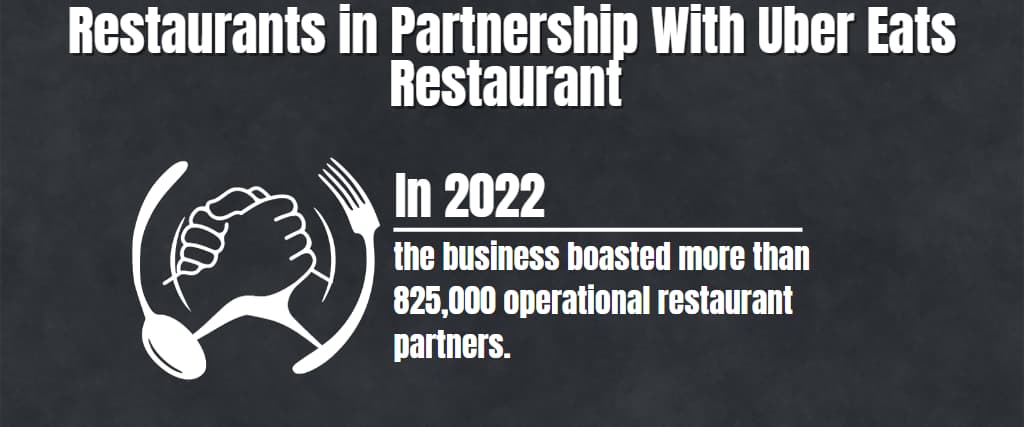
Restaurants in Partnership With Uber Eats Restaurant
In 2022, the business boasted more than 825,000 operational restaurant partners.
This number has increased consistently as more eateries learn about the benefits of working with Uber Eats. By working together, eateries can reach a larger audience and boost their sales.
In addition, Uber Eats gives eateries access to insightful data and information that can be applied to better their services and menu selections. More eateries will likely partner with Uber Eats in the years to come as the meal delivery market continues to grow.
How Long Do Uber Eats Users Take to Choose Food?
It takes Uber Eats users about seven minutes to explore the menu before selecting.
They think about their preferences for cuisine, budget, restaurant score, and lead time. Plus, most consider any constraints they can have, payment options, and any discounts they might offer.
Customers typically spend three to five minutes tailoring their order after selecting food. The entire procedure can take up to fifteen minutes based on the order’s intricacy and the customer’s specific requests.
The Demographics Stats of Uber Eats Users
According to a recent survey, Uber Eats is used by people of various ages, nationalities, and socioeconomic backgrounds. Most users are in their 20s, followed by those in their 30s and 40s, and finally, those in their 50s and 60s.
People who live in large cities but only have a little time to cook find the site extremely useful. Uber Eats is widely used because it provides users with easy access to a wide range of dishes from nearby restaurants in a short time.
Stats of Users by Gender
According to research, 54.02% of customers who use Uber Eats to place an online meal order are male, while 45.98% are female.
Android Uber Eats Downloads Stats
Nearly 47 million people worldwide downloaded the Uber Eats app by 2022, making it among the most well-liked food app.
The Android version of the program has reportedly been downloaded more than 100 million times throughout the globe throughout its existence, as stated by Google Play.
What is the Valuation of Uber Eats?
The valuation of Uber Eats came in at $20 billion, adding to the total value of its parent firm, which was determined to be $120 billion.
This accomplishment can be credited to Uber’s forward-thinking approach to mobility, which goes beyond ridesharing and includes other transit modes. Uber Eats’s brand name has become more well-recognized as the demand for food delivery services has increased.
In addition, Uber has broadened its company portfolio by launching initiatives like Uber Freight, focusing on providing businesses with transportation and logistics services. It is reasonable to predict other market developments as Uber expands its operations.
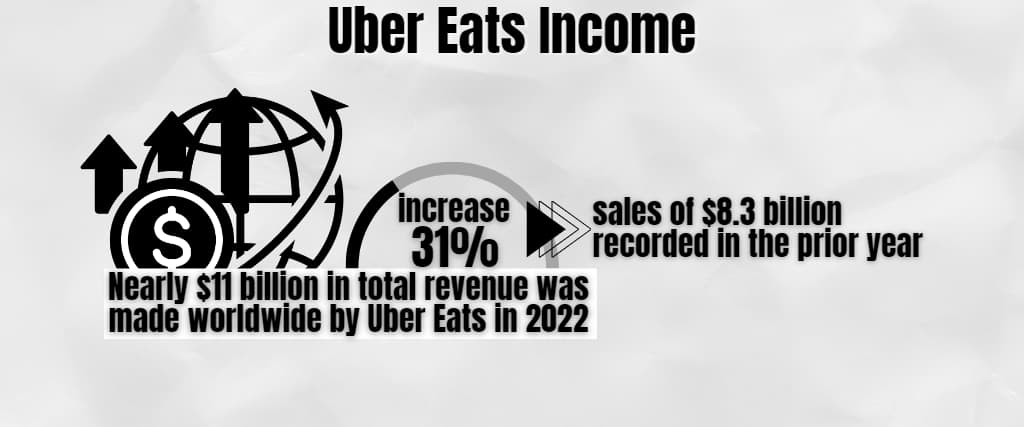
Uber Eats Income
Nearly $11 billion in total revenue was made worldwide by Uber Eats in 2022.
Compared to the sales of $8.3 billion recorded in the prior year, this is a 31% increase.
The rise in income can be ascribed to several factors, including the increased demand for meal delivery services thanks to the COVID-19 outbreak, the growth of Uber Eats in new regions, and the roll-out of new functions, including in-app promos and contactless delivery.
Uber Eats has kept its position among the top companies. This is despite experiencing tough competition from other meal delivery platforms. The achievement can be credited to its easy-to-use interface, quick delivery, and vast range of hotels and dishes.
Acquisitions by Uber Eats
In January 2018, David Chang’s newest business, Ando, was acquired by Uber Eats. Ando is a lunch menu for delivery prepared in a handful of Manhattan’s commercial kitchens. The specifics of the agreement were kept private.
In the same year, the company acquired orderTalk, a Dallas-based firm with a reputation for technological prowess in point-of-sale integration. No specifics were shared with the public. In a recent deal worth roughly $2.65 billion, the third-party delivery service Postmate was bought.
Postmates operates independently, but the business’s infrastructure, including its pool of drivers, is shared with Uber. After the merger was finalised, Uber Eats let go of about 185 Postmates Inc. employees or about 15% of the workforce.
The on-demand beverage delivery firm Drizly was also announced as a target for Uber’s $1.1 billion acquisition plan. During the pandemic, Uber’s ride-hailing business has been struggling to recover, and this strategy aligns with its aspirations to expand its delivery services. The deal to buy has yet to be finalised, though.
| Company | Acquisition Dates |
| Drizly | Oct 13th, 2021, |
| Postmates | Dec 1st, 2020, |
| Careem | January 2nd, 2020 |
| orderTalk | May 22nd, 2019 |
| Ando | Jan 22nd, 2018, |
How Is Uber Eats Making Money?
Uber Eats generates revenue by imposing a commission on all orders placed through the service. This cost is often between 15% and 30% of the order value. Besides the commission charge, Uber Eats provides restaurants with several services, including marketing assistance and consumer information access.
Also, Uber Eats’ delivery partners profit from their collaboration with the company. They get compensated for each delivery they make, so if they can make a lot of deliveries in a day, they can make a nice living.
Furthermore, Uber Eats provides its delivery partners benefits, including extra pay for delivering during peak hours or after regular business hours.
As a whole, Uber Eats has developed a lucrative model that is mutually beneficial to its partner restaurants and its delivery providers. The business can make money by charging eateries a commission for each order placed through its platform. The delivery partners can profit from meeting clients’ needs who want a quick and easy way to purchase food online.
Which Countries have Uber Eats services?
Food delivery service Uber Eats, offered by the company Uber Technologies, has extended its operations around the world.
The company now operates in 45 countries and has over 6,000 locations.
Customers like the fast and reliable service, which allows them to easily place orders from the restaurants they want with minimal effort.
The platform’s increasing popularity can also be attributed to its intuitive design and variety of convenient payment methods. Uber Eats is expected to change the online meal-ordering industry as it grows and connects more businesses with customers.
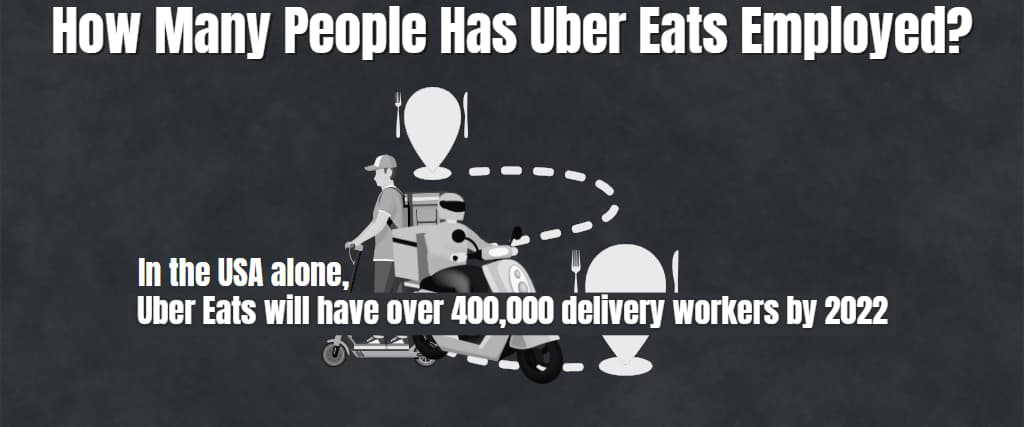
How Many People Has Uber Eats Employed?
In the USA alone, Uber Eats will have over 400,000 delivery workers by 2022.
The business has been increasing and has also boosted its presence abroad. Uber Eats has added new capabilities besides its leading delivery service, including planning deliveries and real-time order tracking.
These improvements have increased customer convenience and strengthened Uber Eats’ status as the industry leader in meal delivery.
Owners of Uber Eats
Uber Eats company was launched by entrepreneurs Chanyu Xu, Travis Kalanick, and Garrett Camp in August 2014.
A former Microsoft developer, Chanyu Xu holds a degree in computer science. Canadian entrepreneur Garrett Camp is widely recognised for his role in establishing Uber. And the American entrepreneur Travis Kalanick is Uber’s co-founder and former CEO.
The company’s head offices are located on the West Coast of the USA, in the San Francisco Bay Area; the corporation is symbolic of the region’s innovative and enterprising spirit.
Uber Eats has had phenomenal growth since its inception, now serving clients in more than 45 nations through partnerships with tens of thousands of businesses.
Mr Garrett Camp
Uber was founded in 2009 by Uber’s current Chairman, Garrett Camp, and Travis Kalanick. Riders can order a ride through the Uber app, and the company will arrange for a driver-independent contractor for a pick-up. In return, drivers pay Uber a commission on each ride.
Mr Camp owns roughly 4% of Uber, a company that had its public trading debut on the NYSE on May 10, 2019. Camp built the web search tool StumbleUpon before starting Uber, and in 2007 he sold it to eBay for $75 million.
Travis Kalanick
The ride-hailing startup Uber co-founder in 2009, Travis Kalanick, stepped down from the CEO position in June 2017. On 31st Dec 2019, he later stepped down from the board of directors.
Currently, he is serving as the Chief Executive Officer of CloudKitchens. This firm operates as a digital restaurant and is financially supported by the Saudi Arabian government.
Before he started Uber, Travis Kalanick co-founded the file exchange platform Scour and the file-sharing startup RedSwoosh. In 2019, he sold his shares, which amounted to around 4% of the company, for a price greater than $2.5 billion before taxes.
Traffic Analysis of Uber Eats
Primary Traffic Sources
Direct traffic accounts for over 68.80% of the total traffic to ubereats.com, most of which comes from desktop computers.
This indicates users accessing the site via a bookmarked website or simply entering the URL.
In addition, 21.43% of all clicks come from organic search results. This means that the majority of visitors to the site come from search engines like Google and Bing.
It is important to note that approximately 90% of all searches into ubereats.com come from these two sources, demonstrating the significance of having a solid online identity and implementing an SEO strategy to draw in and retain consumers.
Uber Eats Social Network Traffic
YouTube is the platform from which users are most likely to go through to Ubereats.com. Facebook and Insta closely follow YouTube.
There is evidence that Ubereats would be more successful if it emphasised these channels in its internet marketing approach.
In addition, it might be helpful to investigate the factors that make YouTube the most successful network for generating visitors.
Our research demonstrates that Ubereats may increase its online visibility and clientele by implementing a strategic social media campaign.
Delivery Workers Statistics
In Australia, Uber Eats is responsible for the employment of 59,000 people, a number that has been steadily increasing throughout the company’s history. In 2016, there were 7,000 of them, and in 2017, there were 27,000 of them. After that, it skyrocketed to 46,000 in 2018, followed by 55,000 in 2019, before levelling out.
- Deliveries made during Uber Eats’ busiest times can net drivers an average of $21.6 per hour. Drivers make a mean wage of $20.47 per hour, cyclists $21.92 per hour, and motorcyclists $21.97 per hour.
- Regarding job satisfaction, most employees would say their current arrangements are ideal. The majority (89%) are satisfied with the service they received, while 7% are ambivalent and 5% are dissatisfied.
- Approximately 79% of Uber Eats employees work 20 or fewer hours per week, and only 21% work for 30 or more.
- A third of all employees put in anywhere from 11 to 20 hours weekly.
- Workers for Uber Eats have lives outside of making deliveries; 34% are students, and 79% have other jobs.
- Uber Eats also helps those who couldn’t get a regular job in other ways. Only 7% of its staff would be able to find work in a conventional setting, and another 60% would have a hard time doing so.
- Workers at Uber Eats report high satisfaction (81%), with 82% enjoying their jobs in general, 75% enjoying their schedules, and 67% appreciating their income.
- Background checks for meal delivery drivers cost an average of $37, and the delivery bag costs an additional $45. Car owners have a different service expense of about $0.08 per km, while motorbike and bicycle owners face costs of about $0.06 and $0.04 per kilometre, respectively.
Competitor Statistics
There was a 32% market penetration in Australia’s meal delivery market in 2018.
- First place went to Uber Eats with 19.5% market share, Menulog with 18.6%, Deliveroo with 9.7%, and Foodora with 5.3%.
- Australians spend a considerable percentage of their monthly budgets on online food delivery services. The average monthly spending by Uber Eats customers was $946. Users of Deliveroo and Foodora averaged $836 and $885 in monthly expenditures.
- Each delivery service had a slightly different monthly order average, but only one ever placed up to three orders monthly.
- On average, two orders were placed monthly through Menulog and Deliveroo and two and a half through Uber Eats and Foodora.
- Menulog’s average order value of $39.6 was the highest among the services we analysed, followed by Uber Eats’ $36.5, Deliveroo’s $34.4, and Foodora’s $33.7.
Since then, the average amount Australians spend on meal delivery services has increased.
- Menulog and Uber Eats reported that customers were paying $44 on average for each delivery order by that year’s February.
- Customers who used DoorDash spent an average of $39 an order, while those who used Deliveroo spent an average of $51.
Impact of COVID-19 Pandemic Uber Eats
- During the COVID-19 outbreak, many Uber Eat drivers, over 77%, did not qualify for federal aid.
- VISA limits were mentioned as the primary cause of ineligibility by 65% of this workforce.
- As a hedge against the pandemic’s ill effects, 60% of the delivery personnel signed up with Uber Eats.
- As a result of the COVID-19 epidemic, 31% of employees worked longer hours than usual.
- The COVID-19 pandemic has caused Australians to spend a surplus of 210% on Uber Eats services than they were before.
About Uber Eats in Australia
With the debut of Uber Eats in 2014, the car ridesharing business Uber attempted to diversify into the food delivery market. Simply put, Uber Eats is an Uber service dedicated to bringing clients food, drinks, and groceries. The service originated in California’s San Francisco and is now available in many other locations.
The business strategy behind Uber Eats is straightforward. The Uber Eats app allows the customer to quickly peruse the available menu options, make an order, and monitor its progress through to delivery. There is a wide selection of dinners, groceries, and restaurants to choose massive amounts of money poured into Uber Eats; the company has yet to profit.
Once the company’s reach is broad enough and the market stable, it expects a financial gain. Since the number of orders increased due to the COVID-19 epidemic, the company’s lack of profitability may be a cause for concern. The business model could also be criticised for not being profitable because it pays drivers more than what consumers pay for delivery.
How Uber Eats Is Benefitting Quick Service Restaurants In Australia
The use of delivery applications is familiar in many countries. In Australia, where a penchant for fast food and other convenience dining shows no signs of abating, they have gained significant ground. Then along came Uber Eats.
The application’s reception in Australia has significantly increased since its debut in the country in 2016. There’s a good reason for that. Uber Eats provides the utmost convenience, with access to more than 30,000 restaurants at the tap of a button.
In addition, during the COVID-19 outbreak, Uber Eats was a crucial lifeline for numerous eateries. Since they could no longer offer table service, they were forced to focus on takeaway and delivery. In these trying times, Uber Eats has consistently been there, offering a boost to struggling eateries.
Here is how Uber Eats has helped restaurants in Australia:
1. More Customers
With Uber Eats now available in Ten of Australia’s most populous cities, eateries have access to a massive new market. Uber’s huge user base is an essential source of revenue for eateries. In Australia, over 60% of the meals delivery app industry is held by Uber Eats alone. Therefore, if someone is seeking a meal delivery service, they may choose Uber Eats.
2. Better Customer Experience
Uber Eats is committed to providing its customers with an exceptional experience. The business has incorporated three features—Instagram integration, user ratings, and Top Eats—into its app based on what it has learned about the customer experience. These additions allow Uber Eats to separate from the competition while providing clients with a more customised experience.
Restaurants may use platforms like Instagram to showcase their dishes more visually appealingly, which can result in increased foot traffic. Top Eats is Uber Eats’ means of recognising and promoting its best restaurants based on the input they’ve received from its customers. These elements form a solid loyalty loop that attracts and retains customers.
3. Value Beyond the Marketplace
The data gathered by Uber Eats benefits the restaurant industry as a whole. The software allows eateries to monitor their progress in various ways, from front-of-the-house efficiencies like the volume of orders and ETA to back-of-the-house ones like driver tracking. With this information, businesses can fine-tune their procedures and make more informed judgments about menu items and prices.
For eateries that want to handle their deliveries, Uber Eats also provides a delivering-as-a-service solution. This allows eateries to leverage Uber Eats as a delivery venue without compromising their brand or the quality of their customer’s experiences.
How to order food using Uber Eats
Although the service’s interface is straightforward, there are a few quirks to be aware of to ensure a problem-free first meal.
- If you already have an Uber account, you can use the same credentials to access the Uber Eats website or mobile app.
- Locate a specific eatery or kind of food (“Italian”) or menu item (“pizza”) by clicking on the “Search” button at the bottom of the application.
- Price, delivery costs, and diet restrictions are just some of the many filtering options available while looking for a meal.
- It is possible to place a group order when shopping online. Choose a dining establishment, and then click “Start Group Order.”
- Take your time getting a purchase delivered. Instead, you can submit your order in advance and choose a convenient delivery time. To schedule a delivery later, go to the website’s “Deliver now” tab and select “Schedule for later.”